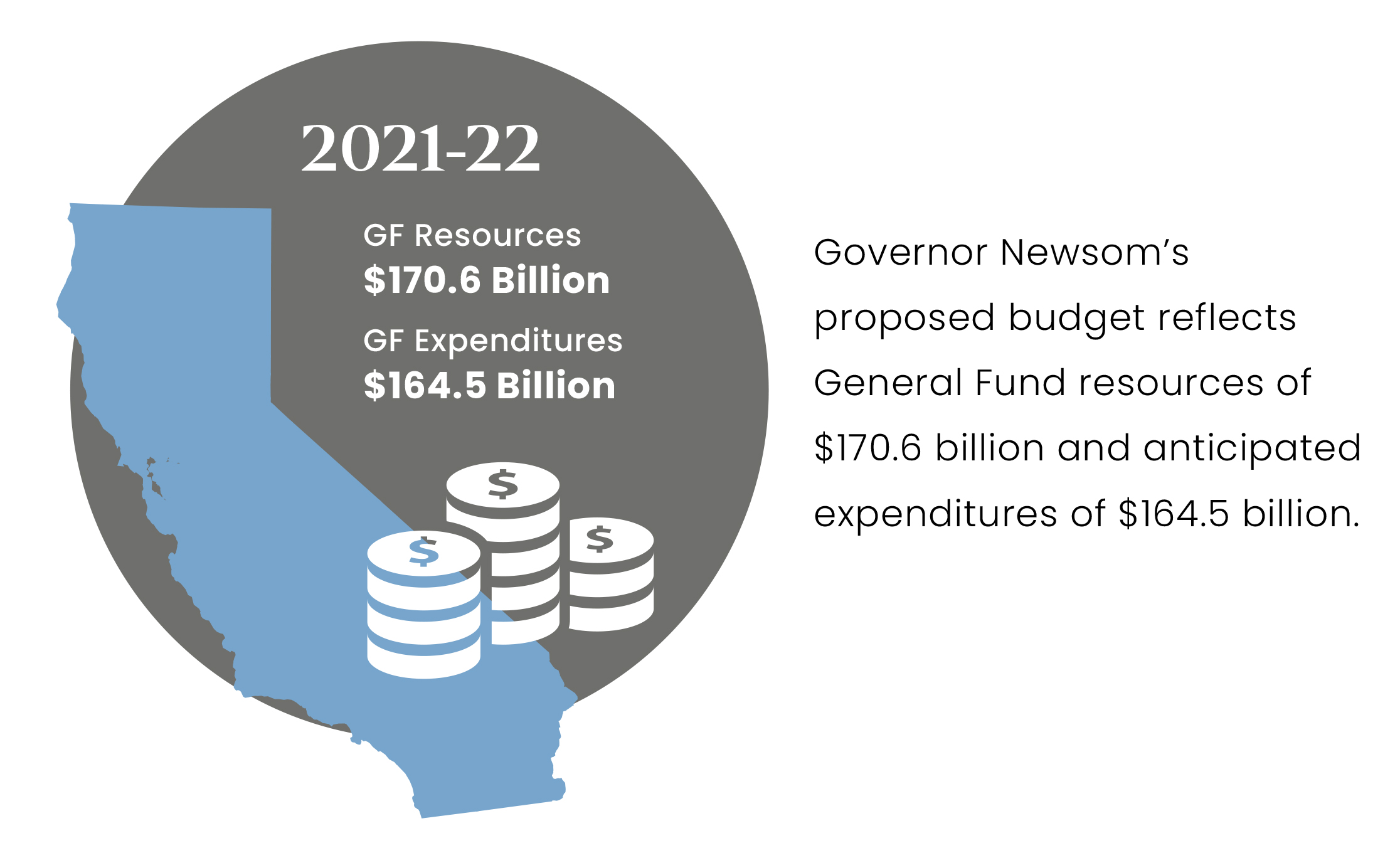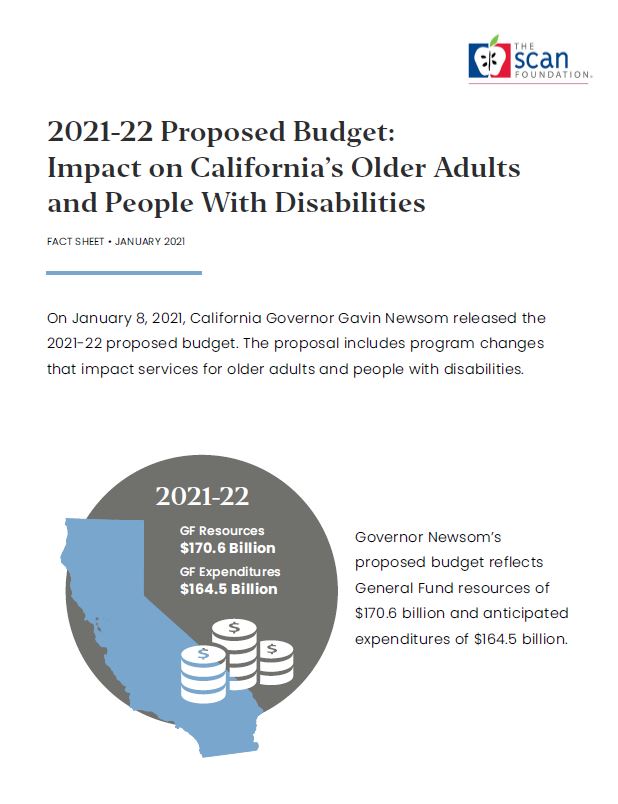2021-22 Proposed Budget: Impact on California’s Older Adults and People With Disabilities
summary
On January 8, 2021, California Governor Gavin Newsom released the 2021-22 proposed budget. The proposal includes program changes that impact services for older adults and people with disabilities.
Date Updated: 01/20/2021Overview
On January 8, 2021, Governor Gavin Newsom released the 2021-22 proposed budget, outlining the state’s projected revenues and spending plan for the fiscal year beginning on July 1, 2021, and ending June 30, 2022. The overall economic impact and forecast has improved since enactment of the Budget Act of 2020 with revenue estimates for budget year 2021-22 increasing by $28.2 billion. The proposed budget includes total General Fund (GF) resources of $170.6 billion and anticipated expenditures of $164.5 billion, with the rest held in reserve. The proposed budget reflects a Budget Stabilization Account* balance of $15.6 billion, and a Safety Net Reserve† balance of $450 million.2,3

Governor Newsom’s 2021-22 proposed budget outlines his top priorities for the year ahead—including health care access, affordable housing, economic security, and other initiatives that impact older adults and people with disabilities. The budget also includes a $14 billion investment in economic recovery related to COVID-19.2
Priorities Elevated in the Budget
Master Plan for Aging: On January 6, 2021, Governor Newsom released the Master Plan for Aging (Master Plan), creating an opportunity to address the needs of aging Californians through a thoughtful, comprehensive, person-centered, and outcomes-oriented strategy. Initiated by the governor’s call for a Master Plan in Executive Order N-14-19, the state engaged stakeholders in a 14-month planning process. The Master Plan serves as a ten-year blueprint for public and private entities at the state, regional, and local levels to address system challenges and transform services across issues, such as housing, transportation, health care, and long-term services and supports. The governor’s proposed budget begins to support key components of the Master Plan to improve the systems of care with a focus on addressing ageism, ableism, and systemic racism.2,4
Focus on Equity: The COVID-19 pandemic has laid bare system inequities and disparities, as evidenced by its impact on older adults and people with disabilities, especially in Black, Native American, Asian and Pacific Islander, and Latino communities. The governor’s proposed budget, as well as the Master Plan for Aging, highlights equity as a critical value to elevate throughout the state’s budget and policy initiatives. Specifically, the proposed budget focuses on addressing need for a more culturally and linguistically competent, as well as responsive, care delivery system through the development of data, quality metrics, and service delivery standards.2
Budget Proposals Impacting Older Adults and People With Disabilities
The governor’s proposed budget includes significant new investments that impact California’s older adults and people with disabilities while maintaining funding for established programs and services. Several investments are supported by the use of one-time funds and continued COVID-19 stimulus funding.2,5 Table 1 provides an overview of those proposals that align with initiatives in the Master Plan.
| Table 1: Proposed Budget Items Aligned With the Master Plan for Aging2,4-6 | ||
| PROGRAM AND LINK TO MASTER PLAN | PROPOSED BUDGET ACTION | ESTIMATED INVESTMENT |
| State Leadership | ||
| Senior Advisor on Aging, Disability, and Alzheimer’s Master Plan Initiatives 96 and 99 |
Establishment of a position within the governor’s office to lead on cross-Cabinet initiatives and cross-sector partnerships | |
| Office of Medicare Innovation and Integration Master Plan Initiatives 34 and 35 |
Establishes the Office of Medicare Innovation and Integration, which will focus on Medicare-only and dual-eligible policy opportunities |
Proposal to be submitted in spring 2021 |
| Master Plan Leadership/Operations Master Plan Initiative 104 |
State implementation of the Master Plan | $5 million GF |
| Health and LTSS | ||
| Telehealth Master Plan Initiative 115 |
Expand and make permanent certain telehealth COVID-19 flexibilities, and add remote patient monitoring services as a Medi-Cal covered benefit | $94.8 million ($34 million GF) |
| California Advancing and Innovating Medi-Cal (CalAIM) Master Plan Initiative 36 |
Implementation of CalAIM beginning January 1, 2022. The investment includes:
|
$1.1 billion ($531.9 million GF) |
| Aging and Disability Resource Center (ADRC) Master Plan Initiative 98 |
Statewide expansion of ADRC program and development of a statewide portal—subject to suspension on December 31, 2022 | $7.5 million GF |
| Geriatric workforce Master Plan Initiative 54 |
Funds for the Office of Statewide Health Planning and Development to grow and diversify the geriatric medicine workforce | $3 million GF± |
| In-Home Supportive Services (IHSS) Master Plan Initiative 39 |
Extends the IHSS COVID-19 backup provider system and wage differential to avoid disruptions to caregiving through December 2021 | $5.3 million GF± |
| Alzheimer’s Disease | ||
| Alzheimer’s disease provider training Master Plan Initiative 55 |
Expanded health care provider training in Alzheimer’s disease and standards of care | $2 million GF± |
| Alzheimer’s disease research Master Plan Initiative 62 |
Research addressing disparities and equity in Alzheimer’s disease | $4 million GF± |
| Alzheimer’s disease brain health campaign Master Plan Initiative 63 |
Department of Public Health public education campaign on brain health | $5 million GF± |
| Alzheimer’s disease caregiver training Master Plan Initiative 112 |
Caregiver training and certification program | $4 million GF± |
| Dementia-friendly communities Master Plan Initiative 23 |
Grants to communities to become dementia-friendly |
$2 million GF± |
| Housing | ||
| Housing and Services Master Plan Initiative 117 |
Department of Social Services to acquire and rehabilitate Adult Residential Facilities and Residential Care Facilities of the Elderly to expand housing for homeless, older adults or those at risk for homelessness | $250 million GF± |
| Housing/Homelessness Master Plan Initiatives 1 and 2 |
Investments in housing grants, loans, tax credits, property acquisitions, and supportive services to meet Housing for All goals | $8 billion |
Due to the improved revenue estimates and federal COVID-19 funding, the budget does not include any reductions to programs or services targeted to older adults and people with disabilities. Table 2 highlights several key investments beyond core health and supportive service program funding that do not have a direct connection to the Master Plan.
| Table 2: Other Key Budget Investments 2,4,5 | ||
| PROGRAM | PROPOSED BUDGET ACTION | ESTIMATED INVESTMENT |
| Equity | ||
| Equity | California Health and Human Services Agency to conduct an analysis of the intersection of COVID-19, health disparities, and health equity to help inform any future response | $1.7 million GF |
| Health and LTSS | ||
| IHSS | IHSS program funding that includes a 10% GF increase over the revised 2020-21 level | $16.5 billion ($5.3 billion GF) |
| IHSS | Delays suspension of the across-the board 7% reduction in service hours until December 31, 2022 | $449.8 million GF |
| Medi-Cal Optional Benefits | Extension of Medi-Cal optional benefits, such as audiology and speech therapy services, incontinence creams and washes, optician/optical lab services, and podiatric services—subject to suspension on December 31, 2022 | $47 million ($15.6 million GF) |
| Economic Security | ||
| Supplemental Security Income/ State Supplemental Payment (SSI/SSP) |
In 2021, maximum SSI/SSP grant levels are $955 per month for individuals and $1,598 per month for couples, and are projected to increase by $17 and $26 respectively as of January 2022 | $2.69 billion GF |
| Food Access | ||
| Senior Nutrition Program |
Additional funding for SNP through December 31, 2022 | $17.5 million GF± |
| Food banks | Support for Emergency Food Assistance Program providers, food banks, tribes, and tribal organizations to mitigate increased food needs related to COVID-19 | $30 million GF± |
| Supplemental Nutrition Benefit and Transitional Nutritional Benefit |
Adjustments to benefit amounts to mitigate the effects of the elimination of the SSI Cash-Out policy | $22.3 million GF |
| California Food Assistance Program Emergency Allotments |
Allows households to receive maximum allowable allotment based on household size | $11.4 million GF± |
Next Steps in the Budget Process
California’s 2021-22 Governor’s Budget requires approval by the Senate and the Assembly prior to being sent to the governor for his signature. Below is a list of key budget dates:
- May 2021 – Release of Governor’s Budget May Revision
- June 15, 2021 – Deadline for Legislature to approve final budget
- July 1, 2021 – Deadline for governor to sign the budget7,8
Download the publication for all visuals and complete references.
Continue Reading
This policy brief provides an introduction to The SCAN Foundation’s CLASS Technical Assistance Brief Series, which explores many of the critical issues to be considered for successfully implementing CLASS.
This policy brief describes the broad needs of individuals with disability and the wide range of supportive and environmental solutions that can allow for the most independent living possible. It suggests how findings on social and environmental supports for individuals with disability can inform implementation of CLASS.
This policy brief provides background on the historical development of benefit eligibility triggers in the private long-term care insurance market. Understanding how these triggers came into being can provide important information to those charged with implementing the CLASS Plan.


